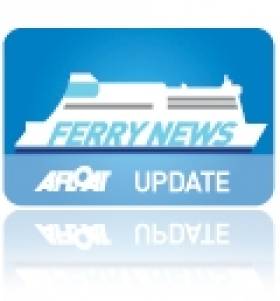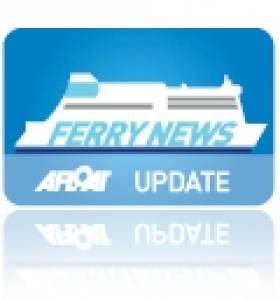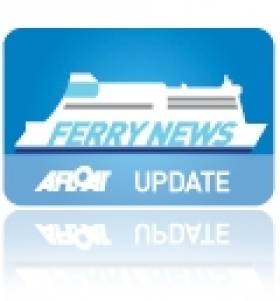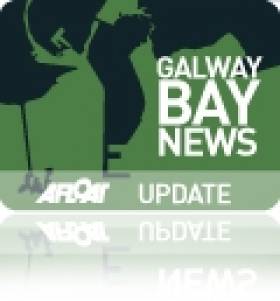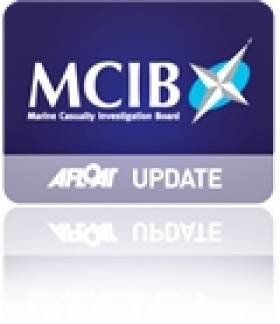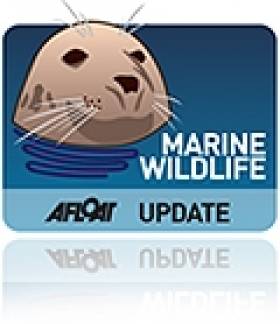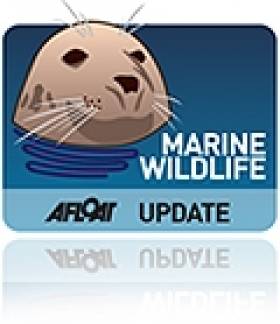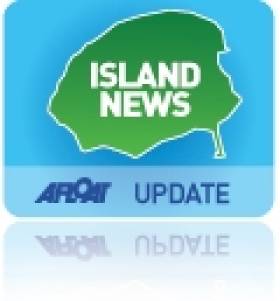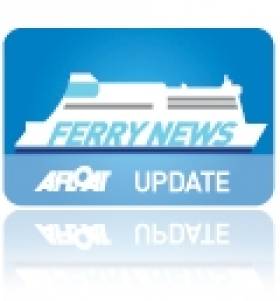Displaying items by tag: ferry
First Ever Ferry Service from Ireland to Spain Announced
#ferry – Minister for Transport, Tourism & Sport Leo Varadkar has welcomed the second significant announcement of a new ferry route into Ireland in a matter of weeks, after LD Ferries confirmed a weekly service from western France and northern Spain.
The LD Ferries service will connect Rosslare with St Nazaire on the west coast of France, and with Gijón in northern Spain.
"This is a very welcome announcement and provides a valuable new landbridge from France and Spain into Ireland. It's the first service of its kind to Ireland, and it's great news for our tourism industry.
"This is the second positive announcement of a new ferry service in a matter of weeks. Last November a new route from Cherbourg to Dublin was announced.
"We are already well serviced in terms of air access, but this new route will help us to grow ferry tourism into Ireland. Driving holidays encourage visitors to spend longer in Ireland and to explore more of the country. It's very good news as we build on the success of The Gathering next year."
Port of Cork adds:
New Ferry Service from Cork to Santander Set to Increase Tourism and Freight in Munster
The Port of Cork Company today welcomed the announcement of a new route into Northern Spain from Cork which is due to commence at the end of April 2018. The service which will make two return sailings a week from Port of Cork to Port of Santander will be operated by Brittany Ferries and will include a weekly return sailing from Cork to Roscoff also.
A new RoPax ship called ‘Connemara’ will be chartered to serve the route which will add much needed capacity to Brittany Ferries existing line to France from Cork. The ship is currently operating on routes between Italy and Greece and will carry around 500 passengers with space for 195 cars. The Port of Cork and Brittany Ferries would expect a fifty-fifty split between passengers and freight carried.
Port of Cork’s Commercial Manager Captain Michael McCarthy said, “The Port of Cork wholeheartedly welcomes a service we have been trying as a port to establish for some time now. We are delighted that our long term customer, Brittany Ferries, has committed to this new service which will see an increase in tourism and freight. The option for freight carriers to bypass the UK land bridge will be seen as very attractive, as Brexit uncertainty continues. We have no doubt that both exporters and importers will make this a viable service.’
At present, there is a range of opinion about possible ‘hard’ and ‘soft’ UK Brexit scenarios, the timing and likely effects. For example, a ‘hard’ border (at ports and across Irish Sea) would mean Customs controls for ports serving the UK, increasing the need for this direct service between Ireland and Spain and an opportunity for Cork as a new ‘centre of gravity’.
The Port of Cork hinterland is the key primary agriculture and Food & Drink output region in the country. The vast majority of the goods imported and exported through Cork are consumables in the perishables arena such as wines, spirits, dairy, water and a wide range of other supermarket products. Freight customers will like this route because the Port of Cork can load and unload quickly thereby enabling customers to get their produce to market quicker, than if they travel through East Coast ports.
This new route to Northern Spain and France will greatly reduce the amount of road miles and therefore providing a lower cost door to door option for shippers. This will provide substantial carbon (CO2) cost saving that is becoming increasingly relevant to companies that are seeking to exhibit their ‘green’ credentials
The new service from Brittany Ferries is expected to be on sale by the end of January.
Guests Stranded On Private Island As Ferry Operator Suspends Service
#FerryNews - Guests and staff were stranded for two hours last night (27 September) in a dispute between a Waterford private island resort and its ferry operator, as RTÉ News reports.
The operator of the ferry to Waterford Castle Island Resort suddenly suspended services at 8pm last night while guests were being served dinner.
Gardaí were called in to help resolve the dispute, and services resumed after two hours, though it is not yet known what agreement was reached.
According to The Irish Times, the resort east of Waterford city on the River Suir – which includes a 19-room hotel, golf course and numerous residential lodges - was appointed a liquidator last month after suffering a financial crash but is still continuing to trade.
Galway Bay Fast Ferry Returns For Two-Week Trial
#GalwayBay - The Ballyvaughan Bay Hop fast ferry service between Galway and Clare will return for a two-week trial this September, as the Galway Independent reports.
Last year the ferry link across Galway Bay from Ballyvaughan in Co Clare to Galway city was trialled to coincide with the Volvo Ocean Race finale and the increased demand for access to the city during the festivities.
This year's trial - using a 12-passenger hard cabin RIB from O'Brien Lines - is intended to access the viability of a permanent fast ferry link across the bay, and how it might integrate with existing local bus and other transport services.
Similar to last summer's service, 10-journey tickets will be on sale for passengers to make a saving, and a special early bird discount is available till 23 August. For more see the Ballyvaughan Bay Hop website HERE.
Galway Port Expansion '99 Per Cent Ready To Go'
#GalwayHarbour - Plans for the expansion of Galway Harbour are "99 per cent ready to go", as the Galway Independent reports.
Eamon Bradshaw, CEO of the Galway Harbour Company, said that the application for the new development would be submitted by the end of June.
As previously reported on Afloat.ie, the scheme will be the first Irish project lodged under new legislation that provides for planning permission on the grounds of "overriding public interest".
Bradshaw says that the necessary Natura Impact Statement has been completed, and economic and financial details were now being finalised for the redevelopment project at the harbour, recently recognised by the Government as a 'port of regional significance'.
Should it get the go-ahead from An Bord Pleanála, the new harbour will extend almost 1km out to sea with 660m of quay berth and plenty of space for cargo and container ships, oil tankers, fishing vessels and passenger ships.
The project will be completed in four phases, with the first €50 million phase extending the port by some 57 acres to accommodate a greater number of commercial ships and modern cruise liners.
Galway City Council recently granted extra time to the Galway Harbour Company for pre-expansion demolition works in the docks area.
The Galway Independent has much more on the story HERE.
Nighttime Navigation Issues Led to Grounding of 'Pirate Queen' - MCIB
#MCIB - "Serious weaknesses" in navigational procedures and practices led to the grounding of a passenger boat at Roonagh Pier in Co Mayo last winter, according to the official report into the incident.
The inter-island passenger ferry Pirate Queen - operated by Clare Island Ferry and Clew Bay Cruises Ltd - grounded on rocks at the entrance to Roonagh Pier on the evening of 20 December 2011 as it made a nighttime approach to the pier.
Two crew were joined by three passengers on board at the time, one of whom served as auxiliary crew while another was injured when the vessel was jolted in heavy swell. The vessel itself, though not holed, sustained severe structural damage.
It emerged that the navigational aid lights on the pier - maintained my Mayo County Council - were not fully functioning at the time of the incident and did not illuminate the waters in the vicinity of the pier, making any approach in darkness a dangerous one, particularly at a location where swells were common at the best of times.
However, the Pirate Queen continued on its heading to Roonagh Pier despite its master being made aware of the lighting issue via SMS shortly after leaving Inishturk.
On approach is was noted that the search light was not manned, and when the lookout reported that the vessel was too far to the east, a large swell forced the boat onto rocks on the east side of the pier.
Lifejackets were immediately put on the passengers, while a fellow ferry master returning home on his RIB was hailed to quickly retrieve the passengers from the boat.
As the ferry was rolling and grinding on the rocks in the heavy swell, one of the passengers was thrown against a bulkhead or the hull and suffered a back injury, though luckily avoided head injury due to the lifejacket. All three passengers were transferred ashore safely via RIB.
In its findings, the Marine Casualty Investigation Board (MCIB) initially focused on the pier lighting, both high-level and navigation lights, noting their vulnerability to storm damage and the lack of effective screening.
But upon further analysis, the report highlighted a number of deficiencies in the running of the ferry service itself, such as the lack of crew rosters to ensure a full complement for any sailing, and the absence of an alternative plan in the event of difficulties landing at Roonagh Pier.
In addition, it noted "an over-reliance of visual aids to navigation and a neglect to practice and use the electronic aids on board.
"When one is very familiar with the waters and on regular passages it is very easy to become complacent," the report stated.
It also noted the "hazardous and unacceptable" decision following the incident to move the boat from Roonagh Pier to Clare Island without informing the Irish Coast Guard of the situation.
The MCIB recommends that the ferry operators devise specific approach instructions, ensure that all employees take part "in the full range of emergency procedures" and that crew rosters be drawn up and displayed. The complete report is available to download below.
Researchers Film Dolphin 'Superpod' In Irish Sea
#MarineWildlife - BBC News has some incredible footage of a 'superpod' comprising hundreds of dolphins in the Irish Sea captured this week.
The video was shot by surprised researchers with the Wales-based Sea Trust on one of the groups routine survey expeditions between Fishguard and Rosslare on board the Stena Europe ferry.
Cliff Benson of the marine wildlife charity described the sea as "boiling" with dolphins just 10 miles off the Irish coast yesterday morning.
"They were just coming and coming. It was the last thing on earth I was expecting in the winter," he said. "We had at least 250 and that's a conservative estimate. I'm guessing there was as many as 500."
The incredible sight comes just a month after the researchers recorded what they called a "dolphin-fest" along the same route west of Tusker Rock, numbering more than a 100 dolphins and 26 porpoises.
BBC News has more on the story HERE - and more footage is available HERE via RTÉ News.
Irish Sea 'Teeming' with Dolphins Says Wildlife Charity
#MARINE WILDLIFE - Large numbers of dolphins have been filmed in the Irish Sea off the Welsh coast by wildlife volunteers, as WalesOnline reports.
The conservationists with the Sea Trust charity, based in Pembrokeshire, recorded the "dolphin-fest" from the deck of the Stena Europe ferry en route from Fishguard to Rosslare.
Sea Trust director Cliff Benson confirmed the sighting of "a pod of eight Risso's dolphins, 40-plus common dolphins [and] four porpoises" among others as soon as the ferry headed west of Tusker Rock.
Altogether in the three-hour passage across the Irish Sea, the volunteer surveyors recorded a total of 99 common dolphins, 10 Risso's dolphins and 26 harbour porpoises. "That's not bad for a winter trip," said Benson.
He added that while there are threats to the Irish Sea's cetaceans from scallop dredging and the like, "to date our surveys show this area is teeming with life.
“This is Wales and Ireland we are talking about not Bermuda so get this amount of dolphin and porpoise activity with whales thrown in as well is incredible."
Stena has welcomed Sea Trust volunteers on board its vessels since 2004 to check on cetaceans and other marine wildlife in the waters between Ireland and the UK on a monthly basis.
And as reported previously on Afloat.ie, Seatruck Ferries has also been providing free passage to UK marine wildlife researchers to discover how many dolphins and seabirds make their home in the Irish Sea.
Meanwhile, BBC News reports that a pod of more than 100 bottlenose dolphins was recently spotted off the Isle of Man.
The Manx Whale and Dolphin Watch said it received a number of sightings from the east and west coasts of the island in the northern half of the Irish Sea, reporting a hive of activity.
"The group sizes tend to be relatively ginormous," said Tom Felce of the group. "So if they are here you can't miss them."
Man Dies After Ferry Fall in Aran Islands
#ISLAND NEWS - A 73-year-old man has died after a fall on a ferry in the Aran Islands at the weekend.
The Irish Times reports that the man, named locally as James McClean, sustained serious head injuries when he fell in a stairwell on the ferry, which was heading to dock at Kilronan Harbour on Inish Mór, on Sunday morning.
According to TheJournal.ie, the man is believed to have been working on the vessel Ceoil na Farraige at the time. He was airlifted by the Irish Coast Guard to Galway University Hospital in serious condition but later died as a result of his injuries.
Collision Captain's Case Sent to Crown Court
#FERRY NEWS - BBC News reports that the captain of the cargo ship that collided with a passenger ferry in Belfast Lough could face up to two years in prison as his case has been sent to Crown Court.
Miroslaw Pozniak, 55, pleaded guilty on Friday to the charge of 'excess alcohol by the master of a ship' after the cargo vessel Union Moon collided with the Stena Feronia close to the Fairway buoy on Wednesday.
Both vessels were substantially damaged in the incident but there are no reports of injuries.
Newtownards Court heard yesterday that Pozniak has been fired by his employer. He will remain in custody until 20 March when the judge will again consider bail.
#FERRY NEWS - The captain of the cargo ship Union Moon, who was arrested after his vessel collided with a passenger ferry in Belfast Lough, has been charged with 'excess alcohol by the master of a ship'.
BBC News reports that the 55-year-old was set to appear in court today, following his arrest yesterday.
No one was injured in the incident on Wednesday, when the Union Moon collided with the Stena Feronia close to the Fairway buoy between Carrickfergus and Helen's Bay. Both vessels were substantially damaged.
The cargo ship, which was carrying 2,000 tonnes of aggregate, was brought back to Belfast. Philip McNamara of the Donaghdee lifeboat confirmed that a large section of her bow was missing.
Meanwhile, engineers from Stena Irish Sea are assessing the damage to their vessel to determine how long it will be out of service. The Stena Feronia sails the route from Belfast to Birkenhead in Merseyside.
The Maritime and Coastguard Agency, the Marine Accident Investigation Branch and the PSNI are all involved in the investigation.
BBC News has more on the story HERE.
- Ferry news
- collision
- Belfast Lough
- cargo ship
- Union Moon
- captain
- charged
- drink
- excess alcohol
- ferry
- Stena Feronia
- Birkenhead
- Merseyside
- court
- Fairway buoy
- Carrickfergus
- Helen's Bay
- Philip McNamara
- Donaghdee
- Lifeboat
- Stena Irish Sea
- Maritime and Coastguard Agency
- Marine Accident Investigation Branch
- psni


























